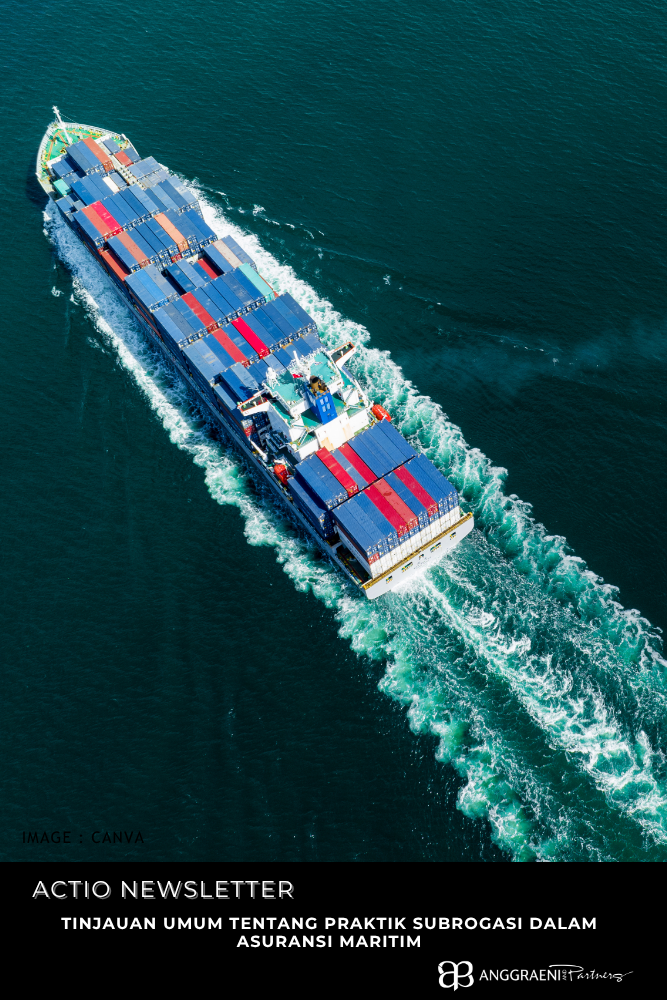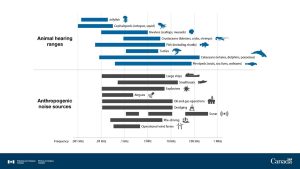Underrated Harm to Marine Environment: Legal Perspectives on Underwater Noise Pollution due to “Horeg” Phenomenon
By Setyawati Fitrianggraeni, Orima Melati Davey
Introduction
Sound is essential for many marine species, functioning as a key sense for communication, navigation, foraging, and avoiding predators. While natural underwater sounds have always existed, the rise of industrial and recreational human activities has significantly increased underwater noise levels. This anthropogenic noise now disrupts marine ecosystems, causing effects that range from masking communication to inducing stress and physical harm in marine life.[1] A recent example is the viral “battle sound horeg”[2] event along the Pasuruan coast in East Java, where vessels equipped with massive sound systems competed to blast loud music over the sea. These unlicensed events occurred near Wates and Semedusari villages and drew concern from environmental observers.[3] International institutions such as NOAA have warned that such noise pollution can interfere with the communication systems of marine mammals like whales and dolphins.
Anthropogenic underwater noise sources generally fall into two categories: incidental, such as noise from shipping or construction, and deliberate, such as sonar or recreational events like the one in Pasuruan. As such activities grow in intensity and reach, their ecological impacts escalate, adding stress to marine species already facing threats like climate change and overfishing. Addressing this issue requires both international and national legal measures. While global agreements impose obligations to protect marine biodiversity, national governments play a crucial role in regulating activities within their waters. The Pasuruan case illustrates the urgent need for clear legal frameworks, proper enforcement, and public awareness to manage and mitigate harmful underwater noise.
Effects of Human-Generated Underwater Noise on Marine Ecosystems
Extreme underwater noise can lead to the death of marine animals within hours, often due to stranding—such as whales beaching shortly after sonar exercises, as reported in areas like Greece, Hawaii, and the U.S. coast. Mass strandings of giant squids in Spain (2001–2003) further illustrate the severe impacts of ocean noise. Noise can also force marine species to relocate, but many fail to adapt, resulting in biodiversity loss.[4]
Ocean noise causes hemorrhages, organ damage, disrupted diving patterns, and panic responses. It also interferes with vital communication, hindering animals’ ability to find mates, locate food, or signal distress. When sounds from different sources share similar frequencies, they can interfere with one another, making it harder to interpret signals accurately. This phenomenon, known as masking, reduces an animal’s ability to detect, recognize, or understand important sounds. Human-generated ocean noise can mask critical acoustic cues from prey, predators, or potential mates. Studies show that marine animals struggle to communicate when anthropogenic noise overlaps in frequency, timing, and location with their own signals.[5] Given the global spread of human activities, masking is likely one of the most widespread and serious threats to marine acoustic communication. Which is illustrated by the Government of Canada as follow:
Ilustration 1. Animal Hearing Range
Source: Government of Canada, ‘Primer on Ocean Noise and Its Impacts’ (2024) 13.
Ocean acidification further reduces the sea’s ability to absorb sound, worsening the problem. As maritime activities expand—from shipping to energy extraction—noise pollution increases. This makes regulation urgent. International bodies like the IMO and IWC have begun addressing the issue, but stronger legal frameworks and coordinated global action are needed to manage underwater noise and protect marine life.[6] Marine mammals depend on underwater sound for critical activities such as hunting, evading predators, identifying their young, and locating mates. Therefore, the lack of adequate measures to protect them from underwater noise pollution can significantly disturb their natural behaviors and threaten marine ecosystems.
Legal Basis under The International Law
As concerns about the impact of anthropogenic underwater noise on the marine environment grow, several international legal instruments have incorporated provisions relevant to marine environmental protection and biodiversity conservation. While these instruments do not explicitly regulate underwater noise as a standalone issue, they provide important normative foundations for addressing its harmful effects.
Matrix on International Legal Frameworks Relevant to the Regulation of Underwater Noise
| Legal Instrument | Relevant Provisions | Contribution to Underwater Noise Regulation |
| UNCLOS (United Nations Convention on the Law of the Sea) | Part XII (Arts. 192, 194, 196, 207–212): States must protect and preserve the marine environment; prevent and control pollution, including through international cooperation | Interprets underwater noise as a form of marine pollution; provides a legal basis for State obligations and international collaboration |
| CBD (Convention on Biological Diversity) | Preamble, Arts. 3, 5, 6, 12, 17–20: States must prevent transboundary harm, conserve biodiversity, adapt national policies, and support developing countries | Frames underwater noise as a threat to marine biodiversity; promotes cooperative mitigation efforts and knowledge-sharing |
| Fish Stocks Agreement | Art. 5(f), Art. 6: Pollution minimization through eco-friendly practices; applies precautionary principle to protect marine ecosystems | Encourages reduction of underwater noise during fishing and related activities; integrates preventive environmental strategies |
| CMS (Convention on Migratory Species) | Art. III(4)(a); 12th COP (2017): Emphasizes habitat protection, marine noise agenda, and inter-agency coordination (e.g. with IMO) | Advocates noise control to protect migratory marine species; offers guidelines for domestic and international standards development |
Source: Adaptation from Yen Chiang Chang and Xu Zhang, ‘Legal Issues Concerning the Impact of Anthropogenic Underwater Noise in the Marine Environment’ (2021) 13 Sustainability (Switzerland) 1, 3-5.
The Urgency of Regulating Underwater Noise Pollution in Indonesia: Reflections from the Horeg Case
The recent case of Horeg, East Flores highlights not only the country’s limited capacity to detect and respond to marine mammal strandings but also the regulatory gap in protecting marine life from anthropogenic acoustic disturbances. Indonesia, as both a maritime and agrarian state, relies heavily on sustainable biodiversity for its food security, economy, and cultural heritage. The ocean plays a central role in national development, providing fisheries, ecosystem services, and serving as an integral part of the country’s identity and livelihoods. Marine mammals, such as whales and dolphins, are not only flagship species but also essential ecological components that help maintain oceanic health and nutrient cycles.
Despite this dependence, Indonesia lacks specific legal instruments governing underwater noise pollution. Activities such as commercial shipping, offshore oil and gas exploration, and military sonar operations generate acoustic disturbances that interfere with marine animals’ communication, navigation, and migration, and in extreme cases, lead to mass strandings and mortality, as allegedly seen in the Horeg case.
Illustration 2. Horeg Sound in Pasuruan
Source: https://malang.pikiran-rakyat.com/news/pr-3538654981/viral-sound-horeg-digelar-di-laut-pasuruan-bikin-warganet-heboh-netizen-colokan-listriknya-pakai-apa
Despite this dependence, Indonesia lacks a comprehensive and specific legal framework governing underwater noise pollution. Current regulatory instruments, such as Law Number 32 of 2009 on Environmental Protection and Management, provide a general mandate to prevent environmental degradation, including from pollution. Similarly, Government Regulation Number 22 of 2021 on Environmental Protection and Management includes environmental impact assessment (AMDAL) requirements that, in principle, could consider acoustic impacts. However, these instruments do not explicitly recognize or regulate underwater noise as a distinct form of pollution, nor do they mandate specific thresholds, monitoring, or mitigation measures for anthropogenic acoustic disturbances. Activities such as commercial shipping, offshore oil and gas exploration, and military sonar operations continue to generate underwater noise that may interfere with marine animals’ communication, navigation, and migration. In extreme cases, such disturbances have been linked to mass strandings and mortality, as allegedly seen in the Horeg case.
Although Indonesia is a State Party to various international conventions, including the United Nations Convention on the Law of the Sea, the Convention on Biological Diversity, and the Convention on the Conservation of Migratory Species, it has yet to fully translate these commitments into binding national policies or sector-specific regulations that directly address underwater acoustic pollution. The Horeg incident serves as a reminder that Indonesia must urgently develop a clear and enforceable legal framework. This should include provisions for acoustic impact assessments, maximum allowable noise thresholds, and an integrated monitoring and reporting system for underwater noise. Without such measures, the country’s obligations to preserve marine biodiversity and ensure environmental sustainability remain largely aspirational.
Conclusions
The growing evidence of ecological harm caused by anthropogenic underwater noise, as illustrated by global incidents and the recent Horeg case in Indonesia, signals the urgency of regulating this form of pollution. Underwater noise disrupts critical life functions of marine species, from communication and navigation to foraging and reproduction. Masking effects, physiological harm, behavioral changes, and even mortality are among the documented consequences, particularly for marine mammals.
While Indonesia is a party to major international environmental treaties—such as UNCLOS, CBD, and CMS—its national legal framework remains insufficiently equipped to address underwater acoustic pollution. Existing instruments such as Law Number 32 of 2009 on Environmental Protection and Management and Government Regulation Number 22 of 2021 provide only general provisions that could indirectly apply to underwater noise, without specifically recognizing or regulating it. There are no binding noise thresholds, acoustic impact assessment requirements, or dedicated monitoring systems in place.
The Pasuruan “horeg” event serve as critical wake-up calls for us to prevent potential harm to marine biodiversity. As a maritime and agrarian state with profound reliance on ocean biodiversity for its economy, food security, and cultural identity, Indonesia cannot afford to overlook this issue. It is essential for the government to begin developing targeted legal instruments that explicitly address underwater noise pollution, in alignment with its international commitments and national environmental priorities
Bibliography
Ahmed Z, ‘Effects of Noise Pollution from Ships on Marine Life’ (Marine Insight, 2022) <https://www.marineinsight.com/environment/effects-of-noise-pollution-from-ships-on-marine-life/>
Chang YC and Zhang X, ‘Legal Issues Concerning the Impact of Anthropogenic Underwater Noise in the Marine Environment’ (2021) 13 Sustainability (Switzerland) 1
Chou E and others, ‘International Policy, Recommendations, Actions and Mitigation Efforts of Anthropogenic Underwater Noise’ (2021) 202 Ocean and Coastal Management 1 <https://doi.org/10.1016/j.ocecoaman.2020.105427>
Government of Canada, ‘Primer on Ocean Noise and Its Impacts’ (2024)
Rinanda HM, ‘Viral Battle Sound Horeg Di Pesisir Laut Pasuruan Tak Berizin (Viral Battle Sound Horeg on the Pasuruan Coast Without a Permit)’ (DetikNews, 2025) <https://news.detik.com/berita/d-7920694/viral-battle-sound-horeg-di-pesisir-laut-pasuruan-tak-berizin>
[1] Emily Chou and others, ‘International Policy, Recommendations, Actions and Mitigation Efforts of Anthropogenic Underwater Noise’ (2021) 202 Ocean and Coastal Management 1, 1 <https://doi.org/10.1016/j.ocecoaman.2020.105427>.
[2] “Horeg” (often referred to as “Sound Horeg”) is a term that refers to a large audio system that produces sound at very high volumes, usually used in events such as carnivals or public entertainment. The word “horeg” itself comes from Javanese which means “moving” or “vibrating”, describing the vibrations felt due to the loud sound.
[3] Hilda Meilissa Rinanda, ‘Viral Battle Sound Horeg Di Pesisir Laut Pasuruan Tak Berizin (Viral Battle Sound Horeg on the Pasuruan Coaast Without a Permit)’ (DetikNews, 2025) <https://news.detik.com/berita/d-7920694/viral-battle-sound-horeg-di-pesisir-laut-pasuruan-tak-berizin>.
[4] Zahra Ahmed, ‘Effects of Noise Pollution from Ships on Marine Life’ (Marine Insight, 2022) <https://www.marineinsight.com/environment/effects-of-noise-pollution-from-ships-on-marine-life/>.
[5] Government of Canada, ‘Primer on Ocean Noise and Its Impacts’ (2024) 12.
[6] Yen Chiang Chang and Xu Zhang, ‘Legal Issues Concerning the Impact of Anthropogenic Underwater Noise in the Marine Environment’ (2021) 13 Sustainability (Switzerland) 1, 2.
DISCLAIMER :
This disclaimer applies to the publication of articles by Anggraeni and Partners. By accessing or reading any articles published by Anggraeni and Partners, you acknowledge and agree to the terms of this disclaimer:
No Legal Advice: The articles published by Anggraeni and Partners are for informational purposes only and do not constitute legal advice. The information provided in the articles is not intended to create an attorney-client relationship between Anggraeni and Partners and the reader. The articles should not be relied upon as a substitute for seeking professional legal advice. For specific legal advice tailored to your individual circumstances, please consult a qualified attorney.
Accuracy and Completeness: Anggraeni and Partners strives to ensure the accuracy and completeness of the information presented in the articles. However, we do not warrant or guarantee the accuracy, currency, or completeness of the information. Laws and legal interpretations may vary, and the information in the articles may not be applicable to your jurisdiction or specific situation. Therefore, Anggraeni and Partners disclaims any liability for any errors or omissions in the articles.
No Endorsement: Any references or mentions of third-party organizations, products, services, or websites in the articles are for informational purposes only and do not constitute an endorsement or recommendation by Anggraeni and Partners. We do not assume responsibility for the accuracy, quality, or reliability of any third-party information or services mentioned in the articles.
No Liability: Anggraeni and Partners, its partners, attorneys, employees, or affiliates shall not be liable for any direct, indirect, incidental, consequential, or special damages arising out of or in connection with the use of the articles or reliance on any information contained therein. This includes, but is not limited to, loss of data, loss of profits, or damages resulting from the use or inability to use the articles.
No Attorney-Client Relationship: Reading or accessing the articles does not establish an attorney-client relationship between Anggraeni and Partners and the reader. The information provided in the articles is general in nature and may not be applicable to your specific legal situation. Any communication with Anggraeni and Partners through the articles or any contact form on the website does not create an attorney-client relationship or establish confidentiality.
By accessing or reading the articles, you acknowledge that you have read, understood, and agreed to this disclaimer. If you do not agree with any part of this disclaimer, please refrain from accessing or reading the articles published by Anggraeni and Partners.
For further information, please contact:
WWW.AP-LAWSOLUTION.COM
P: 6221. 7278 7678, 72795001
H: +62 811 8800 427
S.F. Anggraeni
Managing Partner
fitri@ap-IawsoIution.net
Orima Melati Davey
Legal Researcher
Ocean-Maritime-Climate Research Group
orima.md@ap-lawsolution.net





